Critique of Nursing Decision-Making in the Care of Mr. Murphy: COPD
VerifiedAdded on 2022/12/29
|11
|2987
|98
Case Study
AI Summary
This case study analyzes the nursing care provided to Mr. Murphy, a patient with COPD and a recent upper respiratory infection, focusing on the decision-making processes involved in his assessment and treatment. The assignment utilizes the biopsychosocial model to comprehensively evaluate Mr. Murphy's biological, psychological, and social needs, considering factors such as his history of emphysema, smoking habits, and preference to stay at home. The report critiques the current care plan and recommends improvements, including interventions to address his breathing difficulties, sinus tachycardia, and psychosocial needs, such as promoting self-management and providing family support. The recommendations include specific nursing interventions like clearing the airway and providing supplemental oxygen, as well as interventions to address his cardiac rhythm and medication adherence, aiming to enhance his overall well-being and quality of life. This analysis highlights the importance of holistic patient care and evidence-based practices in managing COPD.
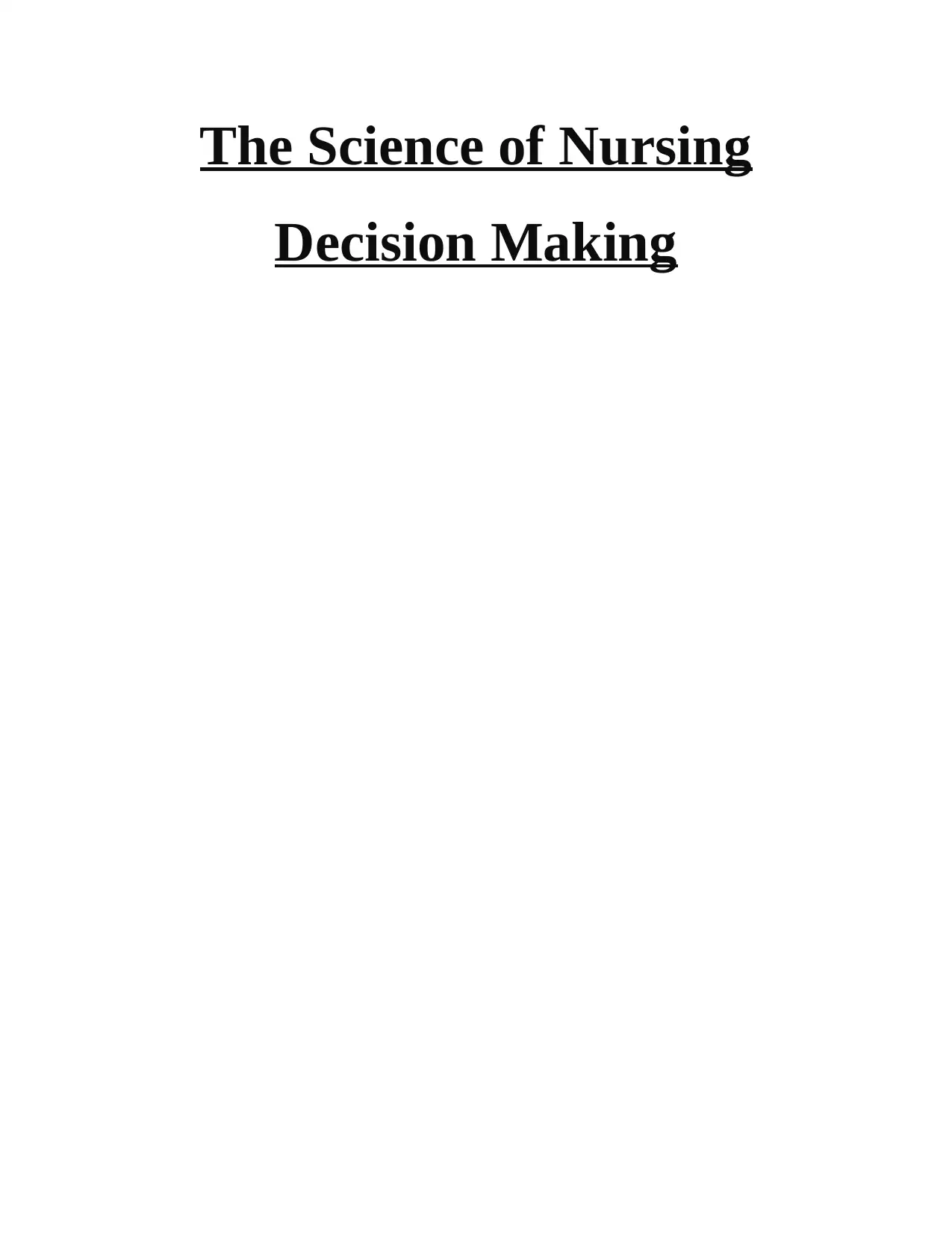
The Science of Nursing
Decision Making
Decision Making
Paraphrase This Document
Need a fresh take? Get an instant paraphrase of this document with our AI Paraphraser
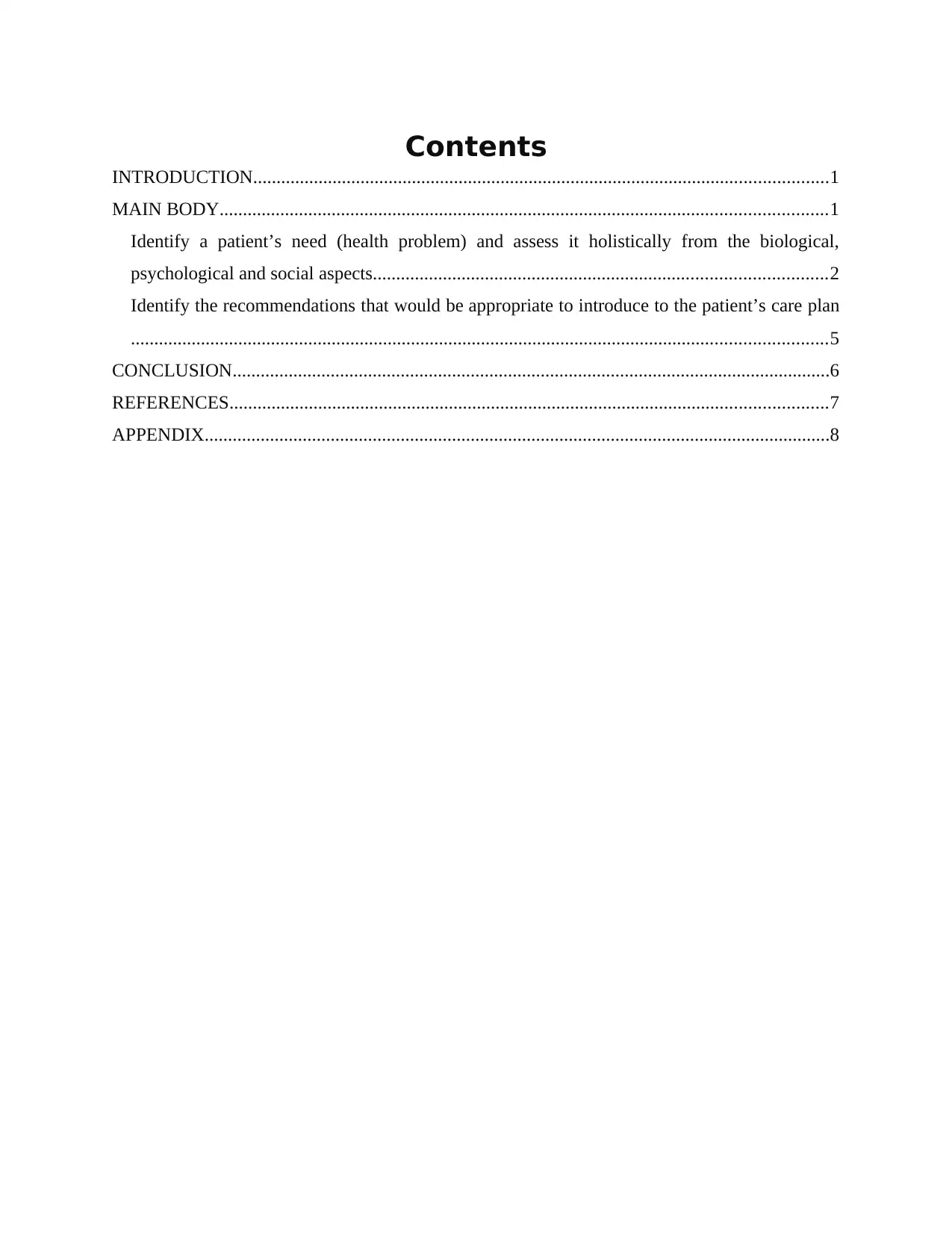
Contents
INTRODUCTION...........................................................................................................................1
MAIN BODY..................................................................................................................................1
Identify a patient’s need (health problem) and assess it holistically from the biological,
psychological and social aspects.................................................................................................2
Identify the recommendations that would be appropriate to introduce to the patient’s care plan
.....................................................................................................................................................5
CONCLUSION................................................................................................................................6
REFERENCES................................................................................................................................7
APPENDIX......................................................................................................................................8
INTRODUCTION...........................................................................................................................1
MAIN BODY..................................................................................................................................1
Identify a patient’s need (health problem) and assess it holistically from the biological,
psychological and social aspects.................................................................................................2
Identify the recommendations that would be appropriate to introduce to the patient’s care plan
.....................................................................................................................................................5
CONCLUSION................................................................................................................................6
REFERENCES................................................................................................................................7
APPENDIX......................................................................................................................................8
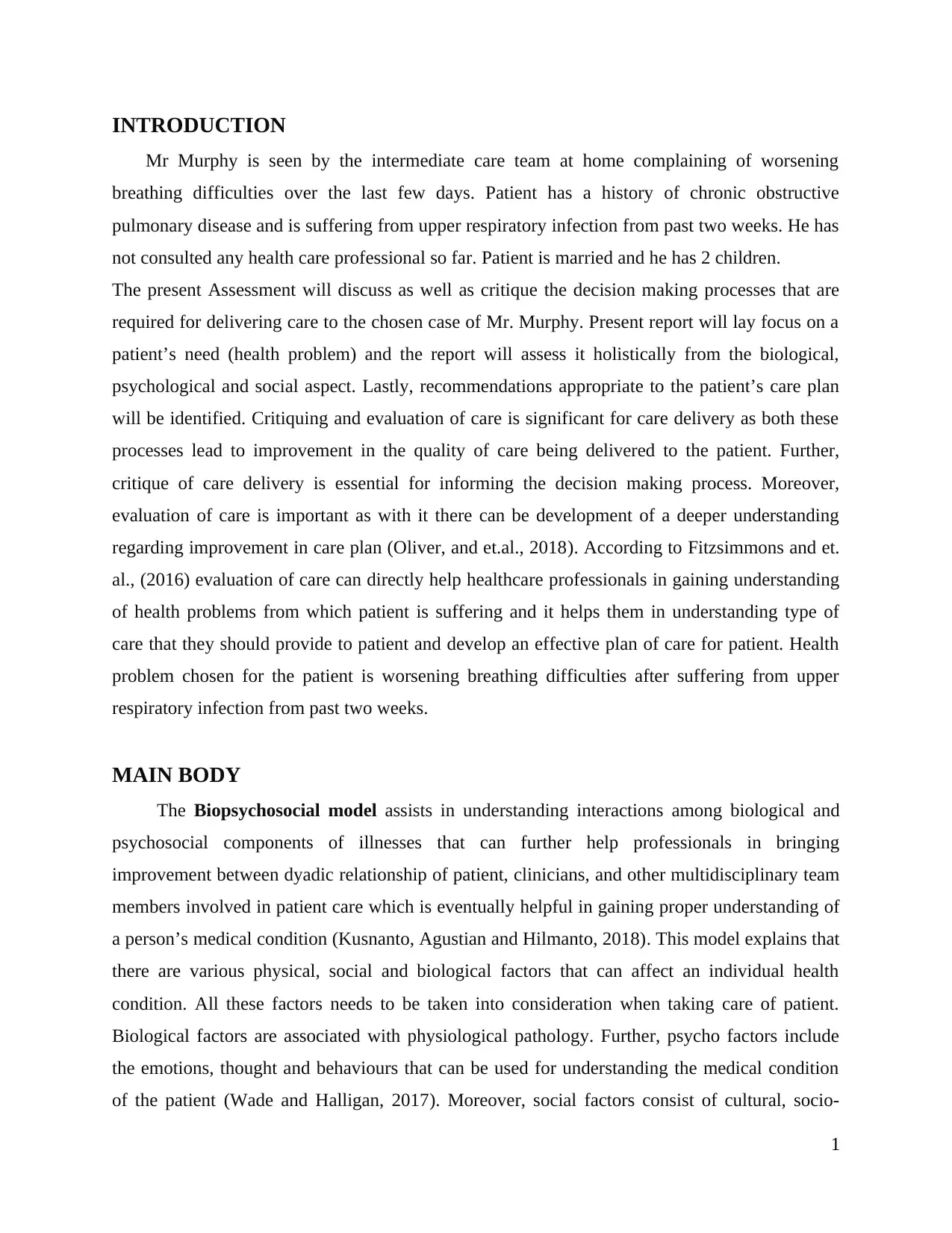
INTRODUCTION
Mr Murphy is seen by the intermediate care team at home complaining of worsening
breathing difficulties over the last few days. Patient has a history of chronic obstructive
pulmonary disease and is suffering from upper respiratory infection from past two weeks. He has
not consulted any health care professional so far. Patient is married and he has 2 children.
The present Assessment will discuss as well as critique the decision making processes that are
required for delivering care to the chosen case of Mr. Murphy. Present report will lay focus on a
patient’s need (health problem) and the report will assess it holistically from the biological,
psychological and social aspect. Lastly, recommendations appropriate to the patient’s care plan
will be identified. Critiquing and evaluation of care is significant for care delivery as both these
processes lead to improvement in the quality of care being delivered to the patient. Further,
critique of care delivery is essential for informing the decision making process. Moreover,
evaluation of care is important as with it there can be development of a deeper understanding
regarding improvement in care plan (Oliver, and et.al., 2018). According to Fitzsimmons and et.
al., (2016) evaluation of care can directly help healthcare professionals in gaining understanding
of health problems from which patient is suffering and it helps them in understanding type of
care that they should provide to patient and develop an effective plan of care for patient. Health
problem chosen for the patient is worsening breathing difficulties after suffering from upper
respiratory infection from past two weeks.
MAIN BODY
The Biopsychosocial model assists in understanding interactions among biological and
psychosocial components of illnesses that can further help professionals in bringing
improvement between dyadic relationship of patient, clinicians, and other multidisciplinary team
members involved in patient care which is eventually helpful in gaining proper understanding of
a person’s medical condition (Kusnanto, Agustian and Hilmanto, 2018). This model explains that
there are various physical, social and biological factors that can affect an individual health
condition. All these factors needs to be taken into consideration when taking care of patient.
Biological factors are associated with physiological pathology. Further, psycho factors include
the emotions, thought and behaviours that can be used for understanding the medical condition
of the patient (Wade and Halligan, 2017). Moreover, social factors consist of cultural, socio-
1
Mr Murphy is seen by the intermediate care team at home complaining of worsening
breathing difficulties over the last few days. Patient has a history of chronic obstructive
pulmonary disease and is suffering from upper respiratory infection from past two weeks. He has
not consulted any health care professional so far. Patient is married and he has 2 children.
The present Assessment will discuss as well as critique the decision making processes that are
required for delivering care to the chosen case of Mr. Murphy. Present report will lay focus on a
patient’s need (health problem) and the report will assess it holistically from the biological,
psychological and social aspect. Lastly, recommendations appropriate to the patient’s care plan
will be identified. Critiquing and evaluation of care is significant for care delivery as both these
processes lead to improvement in the quality of care being delivered to the patient. Further,
critique of care delivery is essential for informing the decision making process. Moreover,
evaluation of care is important as with it there can be development of a deeper understanding
regarding improvement in care plan (Oliver, and et.al., 2018). According to Fitzsimmons and et.
al., (2016) evaluation of care can directly help healthcare professionals in gaining understanding
of health problems from which patient is suffering and it helps them in understanding type of
care that they should provide to patient and develop an effective plan of care for patient. Health
problem chosen for the patient is worsening breathing difficulties after suffering from upper
respiratory infection from past two weeks.
MAIN BODY
The Biopsychosocial model assists in understanding interactions among biological and
psychosocial components of illnesses that can further help professionals in bringing
improvement between dyadic relationship of patient, clinicians, and other multidisciplinary team
members involved in patient care which is eventually helpful in gaining proper understanding of
a person’s medical condition (Kusnanto, Agustian and Hilmanto, 2018). This model explains that
there are various physical, social and biological factors that can affect an individual health
condition. All these factors needs to be taken into consideration when taking care of patient.
Biological factors are associated with physiological pathology. Further, psycho factors include
the emotions, thought and behaviours that can be used for understanding the medical condition
of the patient (Wade and Halligan, 2017). Moreover, social factors consist of cultural, socio-
1
⊘ This is a preview!⊘
Do you want full access?
Subscribe today to unlock all pages.

Trusted by 1+ million students worldwide
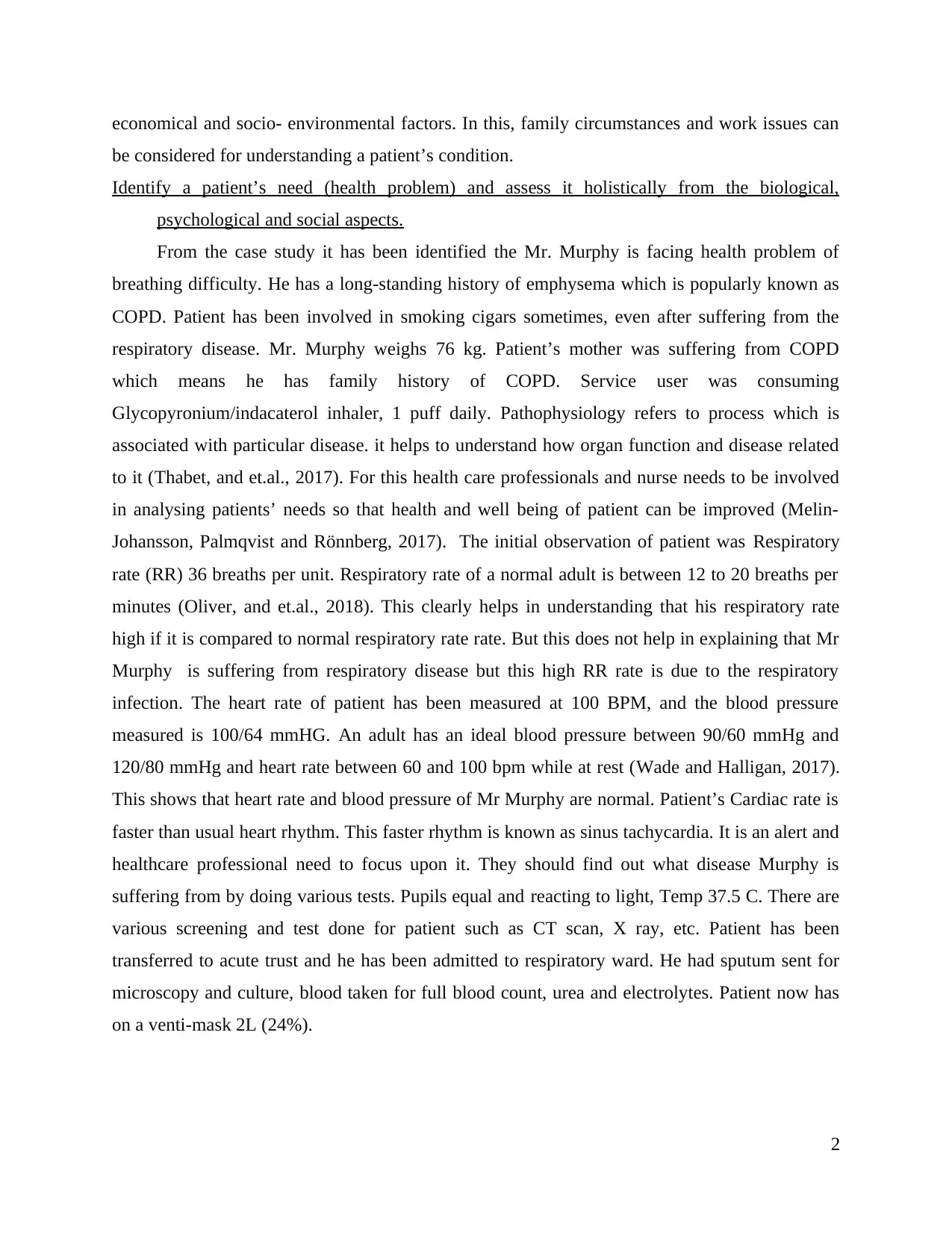
economical and socio- environmental factors. In this, family circumstances and work issues can
be considered for understanding a patient’s condition.
Identify a patient’s need (health problem) and assess it holistically from the biological,
psychological and social aspects.
From the case study it has been identified the Mr. Murphy is facing health problem of
breathing difficulty. He has a long-standing history of emphysema which is popularly known as
COPD. Patient has been involved in smoking cigars sometimes, even after suffering from the
respiratory disease. Mr. Murphy weighs 76 kg. Patient’s mother was suffering from COPD
which means he has family history of COPD. Service user was consuming
Glycopyronium/indacaterol inhaler, 1 puff daily. Pathophysiology refers to process which is
associated with particular disease. it helps to understand how organ function and disease related
to it (Thabet, and et.al., 2017). For this health care professionals and nurse needs to be involved
in analysing patients’ needs so that health and well being of patient can be improved (Melin‐
Johansson, Palmqvist and Rönnberg, 2017). The initial observation of patient was Respiratory
rate (RR) 36 breaths per unit. Respiratory rate of a normal adult is between 12 to 20 breaths per
minutes (Oliver, and et.al., 2018). This clearly helps in understanding that his respiratory rate
high if it is compared to normal respiratory rate rate. But this does not help in explaining that Mr
Murphy is suffering from respiratory disease but this high RR rate is due to the respiratory
infection. The heart rate of patient has been measured at 100 BPM, and the blood pressure
measured is 100/64 mmHG. An adult has an ideal blood pressure between 90/60 mmHg and
120/80 mmHg and heart rate between 60 and 100 bpm while at rest (Wade and Halligan, 2017).
This shows that heart rate and blood pressure of Mr Murphy are normal. Patient’s Cardiac rate is
faster than usual heart rhythm. This faster rhythm is known as sinus tachycardia. It is an alert and
healthcare professional need to focus upon it. They should find out what disease Murphy is
suffering from by doing various tests. Pupils equal and reacting to light, Temp 37.5 C. There are
various screening and test done for patient such as CT scan, X ray, etc. Patient has been
transferred to acute trust and he has been admitted to respiratory ward. He had sputum sent for
microscopy and culture, blood taken for full blood count, urea and electrolytes. Patient now has
on a venti-mask 2L (24%).
2
be considered for understanding a patient’s condition.
Identify a patient’s need (health problem) and assess it holistically from the biological,
psychological and social aspects.
From the case study it has been identified the Mr. Murphy is facing health problem of
breathing difficulty. He has a long-standing history of emphysema which is popularly known as
COPD. Patient has been involved in smoking cigars sometimes, even after suffering from the
respiratory disease. Mr. Murphy weighs 76 kg. Patient’s mother was suffering from COPD
which means he has family history of COPD. Service user was consuming
Glycopyronium/indacaterol inhaler, 1 puff daily. Pathophysiology refers to process which is
associated with particular disease. it helps to understand how organ function and disease related
to it (Thabet, and et.al., 2017). For this health care professionals and nurse needs to be involved
in analysing patients’ needs so that health and well being of patient can be improved (Melin‐
Johansson, Palmqvist and Rönnberg, 2017). The initial observation of patient was Respiratory
rate (RR) 36 breaths per unit. Respiratory rate of a normal adult is between 12 to 20 breaths per
minutes (Oliver, and et.al., 2018). This clearly helps in understanding that his respiratory rate
high if it is compared to normal respiratory rate rate. But this does not help in explaining that Mr
Murphy is suffering from respiratory disease but this high RR rate is due to the respiratory
infection. The heart rate of patient has been measured at 100 BPM, and the blood pressure
measured is 100/64 mmHG. An adult has an ideal blood pressure between 90/60 mmHg and
120/80 mmHg and heart rate between 60 and 100 bpm while at rest (Wade and Halligan, 2017).
This shows that heart rate and blood pressure of Mr Murphy are normal. Patient’s Cardiac rate is
faster than usual heart rhythm. This faster rhythm is known as sinus tachycardia. It is an alert and
healthcare professional need to focus upon it. They should find out what disease Murphy is
suffering from by doing various tests. Pupils equal and reacting to light, Temp 37.5 C. There are
various screening and test done for patient such as CT scan, X ray, etc. Patient has been
transferred to acute trust and he has been admitted to respiratory ward. He had sputum sent for
microscopy and culture, blood taken for full blood count, urea and electrolytes. Patient now has
on a venti-mask 2L (24%).
2
Paraphrase This Document
Need a fresh take? Get an instant paraphrase of this document with our AI Paraphraser
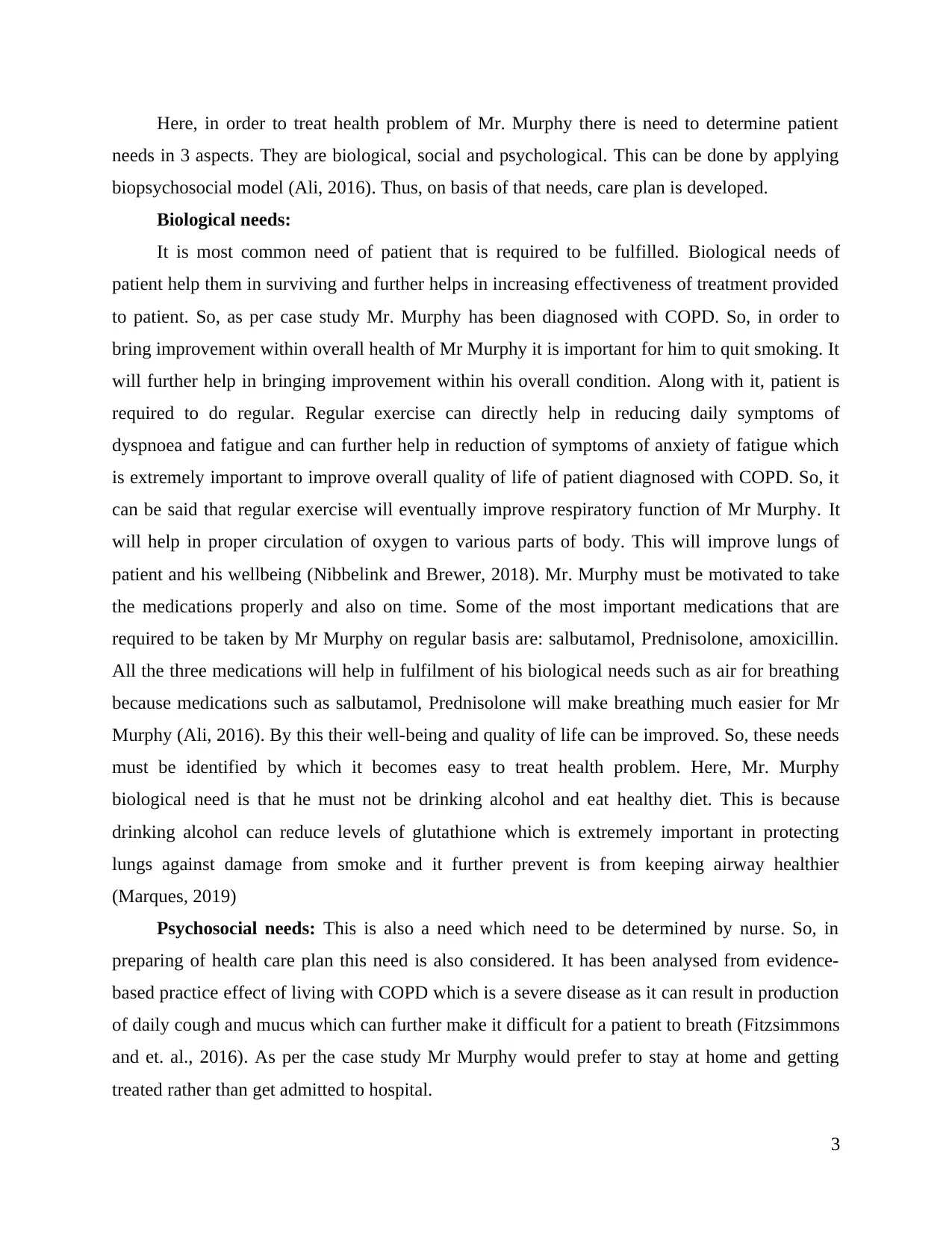
Here, in order to treat health problem of Mr. Murphy there is need to determine patient
needs in 3 aspects. They are biological, social and psychological. This can be done by applying
biopsychosocial model (Ali, 2016). Thus, on basis of that needs, care plan is developed.
Biological needs:
It is most common need of patient that is required to be fulfilled. Biological needs of
patient help them in surviving and further helps in increasing effectiveness of treatment provided
to patient. So, as per case study Mr. Murphy has been diagnosed with COPD. So, in order to
bring improvement within overall health of Mr Murphy it is important for him to quit smoking. It
will further help in bringing improvement within his overall condition. Along with it, patient is
required to do regular. Regular exercise can directly help in reducing daily symptoms of
dyspnoea and fatigue and can further help in reduction of symptoms of anxiety of fatigue which
is extremely important to improve overall quality of life of patient diagnosed with COPD. So, it
can be said that regular exercise will eventually improve respiratory function of Mr Murphy. It
will help in proper circulation of oxygen to various parts of body. This will improve lungs of
patient and his wellbeing (Nibbelink and Brewer, 2018). Mr. Murphy must be motivated to take
the medications properly and also on time. Some of the most important medications that are
required to be taken by Mr Murphy on regular basis are: salbutamol, Prednisolone, amoxicillin.
All the three medications will help in fulfilment of his biological needs such as air for breathing
because medications such as salbutamol, Prednisolone will make breathing much easier for Mr
Murphy (Ali, 2016). By this their well-being and quality of life can be improved. So, these needs
must be identified by which it becomes easy to treat health problem. Here, Mr. Murphy
biological need is that he must not be drinking alcohol and eat healthy diet. This is because
drinking alcohol can reduce levels of glutathione which is extremely important in protecting
lungs against damage from smoke and it further prevent is from keeping airway healthier
(Marques, 2019)
Psychosocial needs: This is also a need which need to be determined by nurse. So, in
preparing of health care plan this need is also considered. It has been analysed from evidence-
based practice effect of living with COPD which is a severe disease as it can result in production
of daily cough and mucus which can further make it difficult for a patient to breath (Fitzsimmons
and et. al., 2016). As per the case study Mr Murphy would prefer to stay at home and getting
treated rather than get admitted to hospital.
3
needs in 3 aspects. They are biological, social and psychological. This can be done by applying
biopsychosocial model (Ali, 2016). Thus, on basis of that needs, care plan is developed.
Biological needs:
It is most common need of patient that is required to be fulfilled. Biological needs of
patient help them in surviving and further helps in increasing effectiveness of treatment provided
to patient. So, as per case study Mr. Murphy has been diagnosed with COPD. So, in order to
bring improvement within overall health of Mr Murphy it is important for him to quit smoking. It
will further help in bringing improvement within his overall condition. Along with it, patient is
required to do regular. Regular exercise can directly help in reducing daily symptoms of
dyspnoea and fatigue and can further help in reduction of symptoms of anxiety of fatigue which
is extremely important to improve overall quality of life of patient diagnosed with COPD. So, it
can be said that regular exercise will eventually improve respiratory function of Mr Murphy. It
will help in proper circulation of oxygen to various parts of body. This will improve lungs of
patient and his wellbeing (Nibbelink and Brewer, 2018). Mr. Murphy must be motivated to take
the medications properly and also on time. Some of the most important medications that are
required to be taken by Mr Murphy on regular basis are: salbutamol, Prednisolone, amoxicillin.
All the three medications will help in fulfilment of his biological needs such as air for breathing
because medications such as salbutamol, Prednisolone will make breathing much easier for Mr
Murphy (Ali, 2016). By this their well-being and quality of life can be improved. So, these needs
must be identified by which it becomes easy to treat health problem. Here, Mr. Murphy
biological need is that he must not be drinking alcohol and eat healthy diet. This is because
drinking alcohol can reduce levels of glutathione which is extremely important in protecting
lungs against damage from smoke and it further prevent is from keeping airway healthier
(Marques, 2019)
Psychosocial needs: This is also a need which need to be determined by nurse. So, in
preparing of health care plan this need is also considered. It has been analysed from evidence-
based practice effect of living with COPD which is a severe disease as it can result in production
of daily cough and mucus which can further make it difficult for a patient to breath (Fitzsimmons
and et. al., 2016). As per the case study Mr Murphy would prefer to stay at home and getting
treated rather than get admitted to hospital.
3
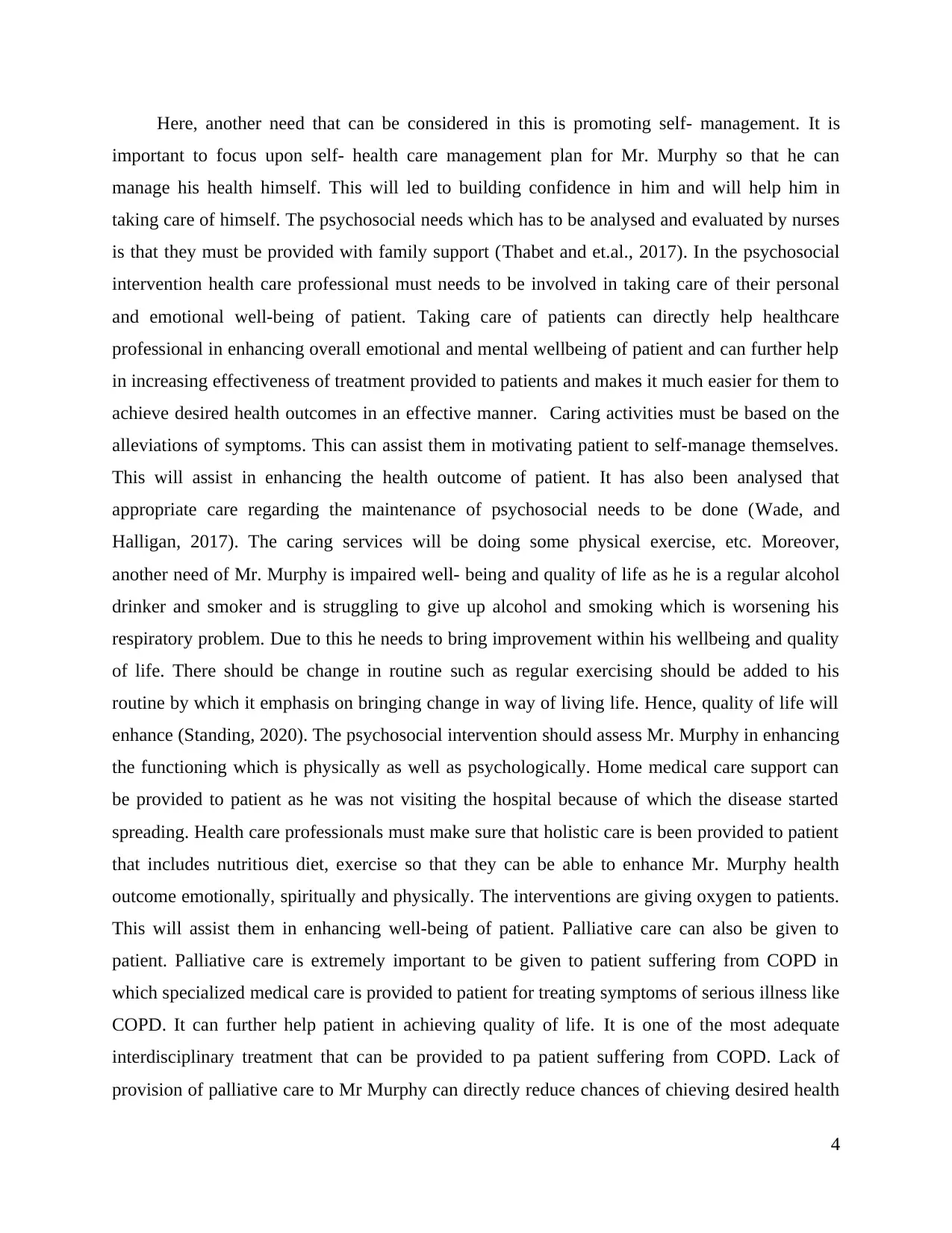
Here, another need that can be considered in this is promoting self- management. It is
important to focus upon self- health care management plan for Mr. Murphy so that he can
manage his health himself. This will led to building confidence in him and will help him in
taking care of himself. The psychosocial needs which has to be analysed and evaluated by nurses
is that they must be provided with family support (Thabet and et.al., 2017). In the psychosocial
intervention health care professional must needs to be involved in taking care of their personal
and emotional well-being of patient. Taking care of patients can directly help healthcare
professional in enhancing overall emotional and mental wellbeing of patient and can further help
in increasing effectiveness of treatment provided to patients and makes it much easier for them to
achieve desired health outcomes in an effective manner. Caring activities must be based on the
alleviations of symptoms. This can assist them in motivating patient to self-manage themselves.
This will assist in enhancing the health outcome of patient. It has also been analysed that
appropriate care regarding the maintenance of psychosocial needs to be done (Wade, and
Halligan, 2017). The caring services will be doing some physical exercise, etc. Moreover,
another need of Mr. Murphy is impaired well- being and quality of life as he is a regular alcohol
drinker and smoker and is struggling to give up alcohol and smoking which is worsening his
respiratory problem. Due to this he needs to bring improvement within his wellbeing and quality
of life. There should be change in routine such as regular exercising should be added to his
routine by which it emphasis on bringing change in way of living life. Hence, quality of life will
enhance (Standing, 2020). The psychosocial intervention should assess Mr. Murphy in enhancing
the functioning which is physically as well as psychologically. Home medical care support can
be provided to patient as he was not visiting the hospital because of which the disease started
spreading. Health care professionals must make sure that holistic care is been provided to patient
that includes nutritious diet, exercise so that they can be able to enhance Mr. Murphy health
outcome emotionally, spiritually and physically. The interventions are giving oxygen to patients.
This will assist them in enhancing well-being of patient. Palliative care can also be given to
patient. Palliative care is extremely important to be given to patient suffering from COPD in
which specialized medical care is provided to patient for treating symptoms of serious illness like
COPD. It can further help patient in achieving quality of life. It is one of the most adequate
interdisciplinary treatment that can be provided to pa patient suffering from COPD. Lack of
provision of palliative care to Mr Murphy can directly reduce chances of chieving desired health
4
important to focus upon self- health care management plan for Mr. Murphy so that he can
manage his health himself. This will led to building confidence in him and will help him in
taking care of himself. The psychosocial needs which has to be analysed and evaluated by nurses
is that they must be provided with family support (Thabet and et.al., 2017). In the psychosocial
intervention health care professional must needs to be involved in taking care of their personal
and emotional well-being of patient. Taking care of patients can directly help healthcare
professional in enhancing overall emotional and mental wellbeing of patient and can further help
in increasing effectiveness of treatment provided to patients and makes it much easier for them to
achieve desired health outcomes in an effective manner. Caring activities must be based on the
alleviations of symptoms. This can assist them in motivating patient to self-manage themselves.
This will assist in enhancing the health outcome of patient. It has also been analysed that
appropriate care regarding the maintenance of psychosocial needs to be done (Wade, and
Halligan, 2017). The caring services will be doing some physical exercise, etc. Moreover,
another need of Mr. Murphy is impaired well- being and quality of life as he is a regular alcohol
drinker and smoker and is struggling to give up alcohol and smoking which is worsening his
respiratory problem. Due to this he needs to bring improvement within his wellbeing and quality
of life. There should be change in routine such as regular exercising should be added to his
routine by which it emphasis on bringing change in way of living life. Hence, quality of life will
enhance (Standing, 2020). The psychosocial intervention should assess Mr. Murphy in enhancing
the functioning which is physically as well as psychologically. Home medical care support can
be provided to patient as he was not visiting the hospital because of which the disease started
spreading. Health care professionals must make sure that holistic care is been provided to patient
that includes nutritious diet, exercise so that they can be able to enhance Mr. Murphy health
outcome emotionally, spiritually and physically. The interventions are giving oxygen to patients.
This will assist them in enhancing well-being of patient. Palliative care can also be given to
patient. Palliative care is extremely important to be given to patient suffering from COPD in
which specialized medical care is provided to patient for treating symptoms of serious illness like
COPD. It can further help patient in achieving quality of life. It is one of the most adequate
interdisciplinary treatment that can be provided to pa patient suffering from COPD. Lack of
provision of palliative care to Mr Murphy can directly reduce chances of chieving desired health
4
⊘ This is a preview!⊘
Do you want full access?
Subscribe today to unlock all pages.

Trusted by 1+ million students worldwide
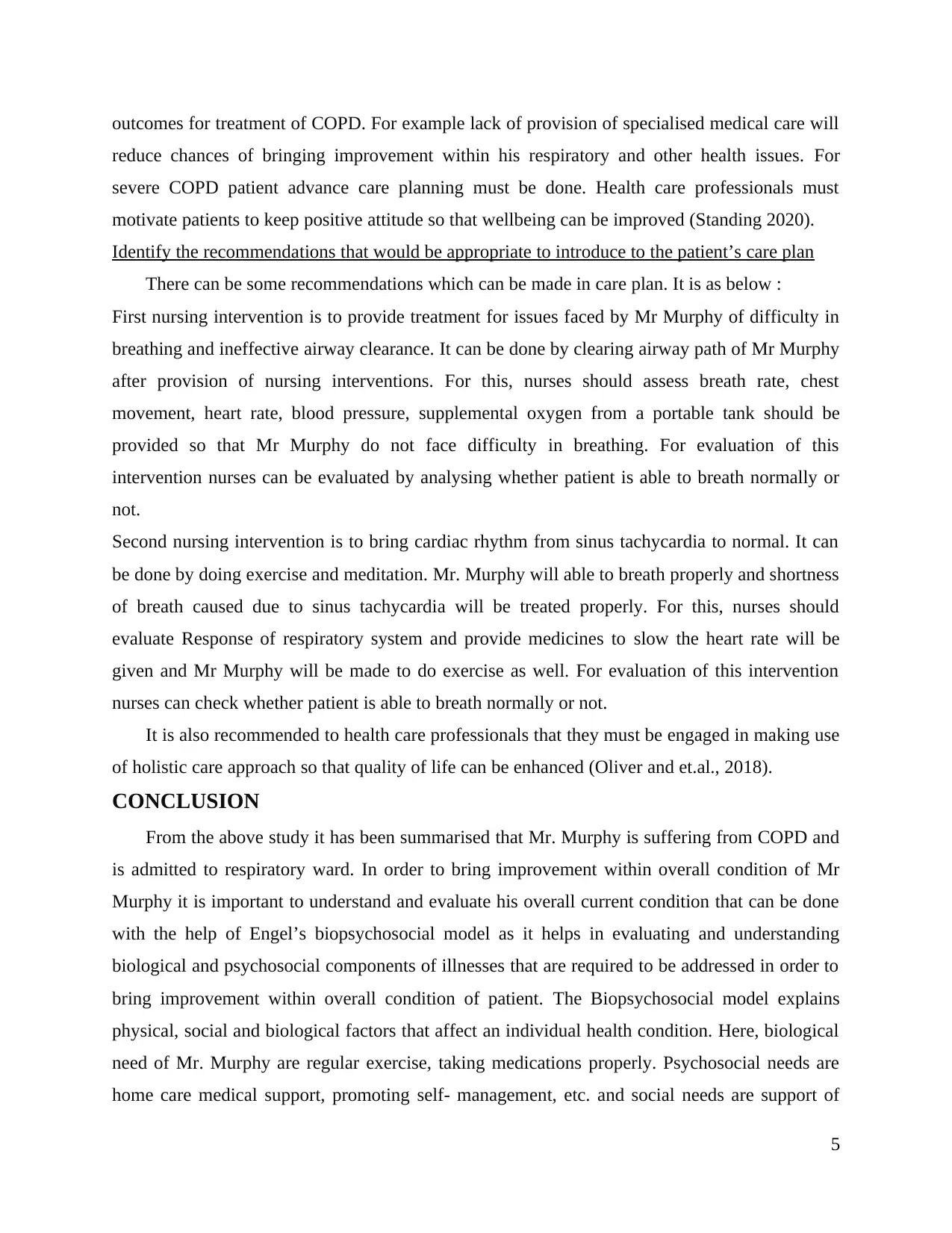
outcomes for treatment of COPD. For example lack of provision of specialised medical care will
reduce chances of bringing improvement within his respiratory and other health issues. For
severe COPD patient advance care planning must be done. Health care professionals must
motivate patients to keep positive attitude so that wellbeing can be improved (Standing 2020).
Identify the recommendations that would be appropriate to introduce to the patient’s care plan
There can be some recommendations which can be made in care plan. It is as below :
First nursing intervention is to provide treatment for issues faced by Mr Murphy of difficulty in
breathing and ineffective airway clearance. It can be done by clearing airway path of Mr Murphy
after provision of nursing interventions. For this, nurses should assess breath rate, chest
movement, heart rate, blood pressure, supplemental oxygen from a portable tank should be
provided so that Mr Murphy do not face difficulty in breathing. For evaluation of this
intervention nurses can be evaluated by analysing whether patient is able to breath normally or
not.
Second nursing intervention is to bring cardiac rhythm from sinus tachycardia to normal. It can
be done by doing exercise and meditation. Mr. Murphy will able to breath properly and shortness
of breath caused due to sinus tachycardia will be treated properly. For this, nurses should
evaluate Response of respiratory system and provide medicines to slow the heart rate will be
given and Mr Murphy will be made to do exercise as well. For evaluation of this intervention
nurses can check whether patient is able to breath normally or not.
It is also recommended to health care professionals that they must be engaged in making use
of holistic care approach so that quality of life can be enhanced (Oliver and et.al., 2018).
CONCLUSION
From the above study it has been summarised that Mr. Murphy is suffering from COPD and
is admitted to respiratory ward. In order to bring improvement within overall condition of Mr
Murphy it is important to understand and evaluate his overall current condition that can be done
with the help of Engel’s biopsychosocial model as it helps in evaluating and understanding
biological and psychosocial components of illnesses that are required to be addressed in order to
bring improvement within overall condition of patient. The Biopsychosocial model explains
physical, social and biological factors that affect an individual health condition. Here, biological
need of Mr. Murphy are regular exercise, taking medications properly. Psychosocial needs are
home care medical support, promoting self- management, etc. and social needs are support of
5
reduce chances of bringing improvement within his respiratory and other health issues. For
severe COPD patient advance care planning must be done. Health care professionals must
motivate patients to keep positive attitude so that wellbeing can be improved (Standing 2020).
Identify the recommendations that would be appropriate to introduce to the patient’s care plan
There can be some recommendations which can be made in care plan. It is as below :
First nursing intervention is to provide treatment for issues faced by Mr Murphy of difficulty in
breathing and ineffective airway clearance. It can be done by clearing airway path of Mr Murphy
after provision of nursing interventions. For this, nurses should assess breath rate, chest
movement, heart rate, blood pressure, supplemental oxygen from a portable tank should be
provided so that Mr Murphy do not face difficulty in breathing. For evaluation of this
intervention nurses can be evaluated by analysing whether patient is able to breath normally or
not.
Second nursing intervention is to bring cardiac rhythm from sinus tachycardia to normal. It can
be done by doing exercise and meditation. Mr. Murphy will able to breath properly and shortness
of breath caused due to sinus tachycardia will be treated properly. For this, nurses should
evaluate Response of respiratory system and provide medicines to slow the heart rate will be
given and Mr Murphy will be made to do exercise as well. For evaluation of this intervention
nurses can check whether patient is able to breath normally or not.
It is also recommended to health care professionals that they must be engaged in making use
of holistic care approach so that quality of life can be enhanced (Oliver and et.al., 2018).
CONCLUSION
From the above study it has been summarised that Mr. Murphy is suffering from COPD and
is admitted to respiratory ward. In order to bring improvement within overall condition of Mr
Murphy it is important to understand and evaluate his overall current condition that can be done
with the help of Engel’s biopsychosocial model as it helps in evaluating and understanding
biological and psychosocial components of illnesses that are required to be addressed in order to
bring improvement within overall condition of patient. The Biopsychosocial model explains
physical, social and biological factors that affect an individual health condition. Here, biological
need of Mr. Murphy are regular exercise, taking medications properly. Psychosocial needs are
home care medical support, promoting self- management, etc. and social needs are support of
5
Paraphrase This Document
Need a fresh take? Get an instant paraphrase of this document with our AI Paraphraser
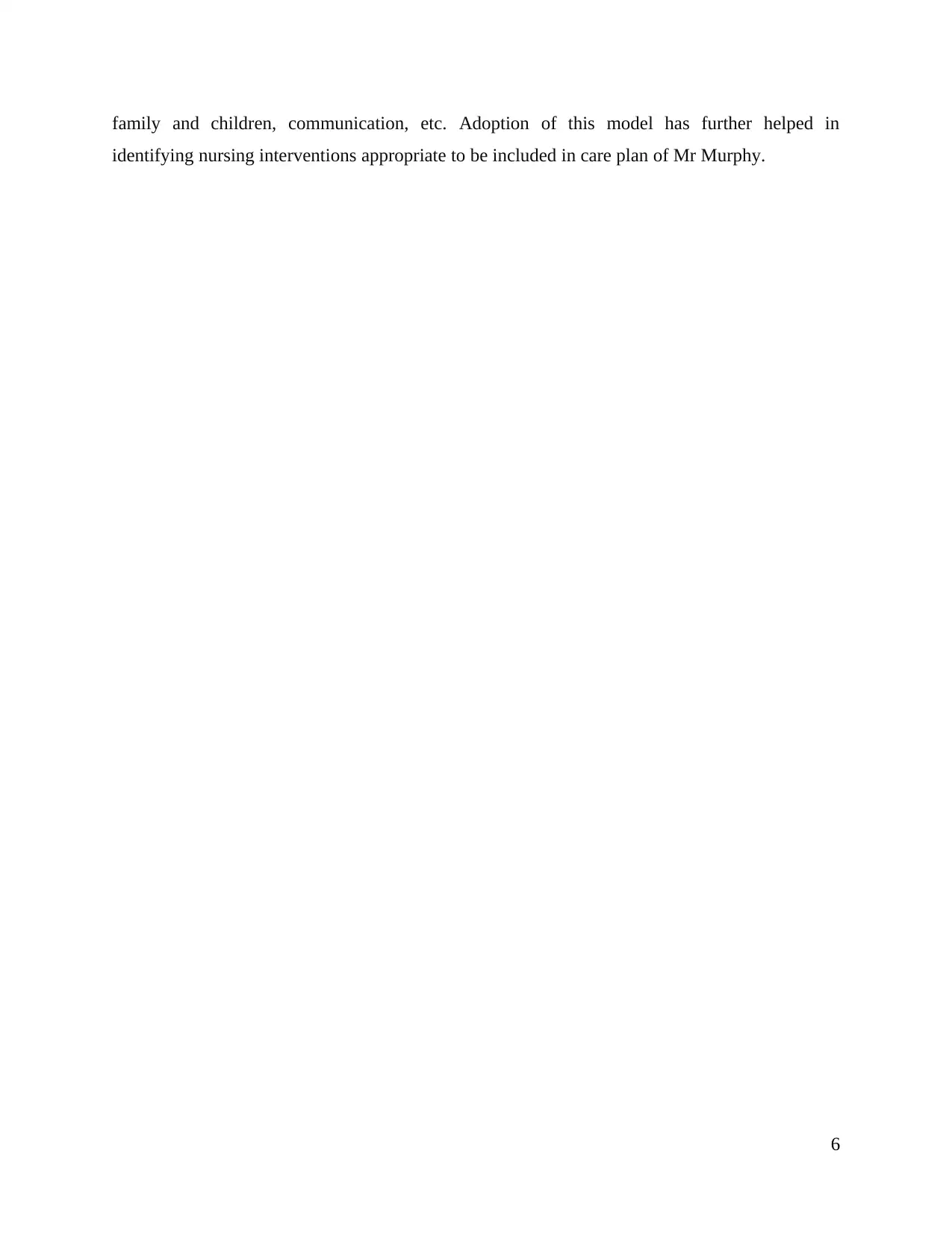
family and children, communication, etc. Adoption of this model has further helped in
identifying nursing interventions appropriate to be included in care plan of Mr Murphy.
6
identifying nursing interventions appropriate to be included in care plan of Mr Murphy.
6
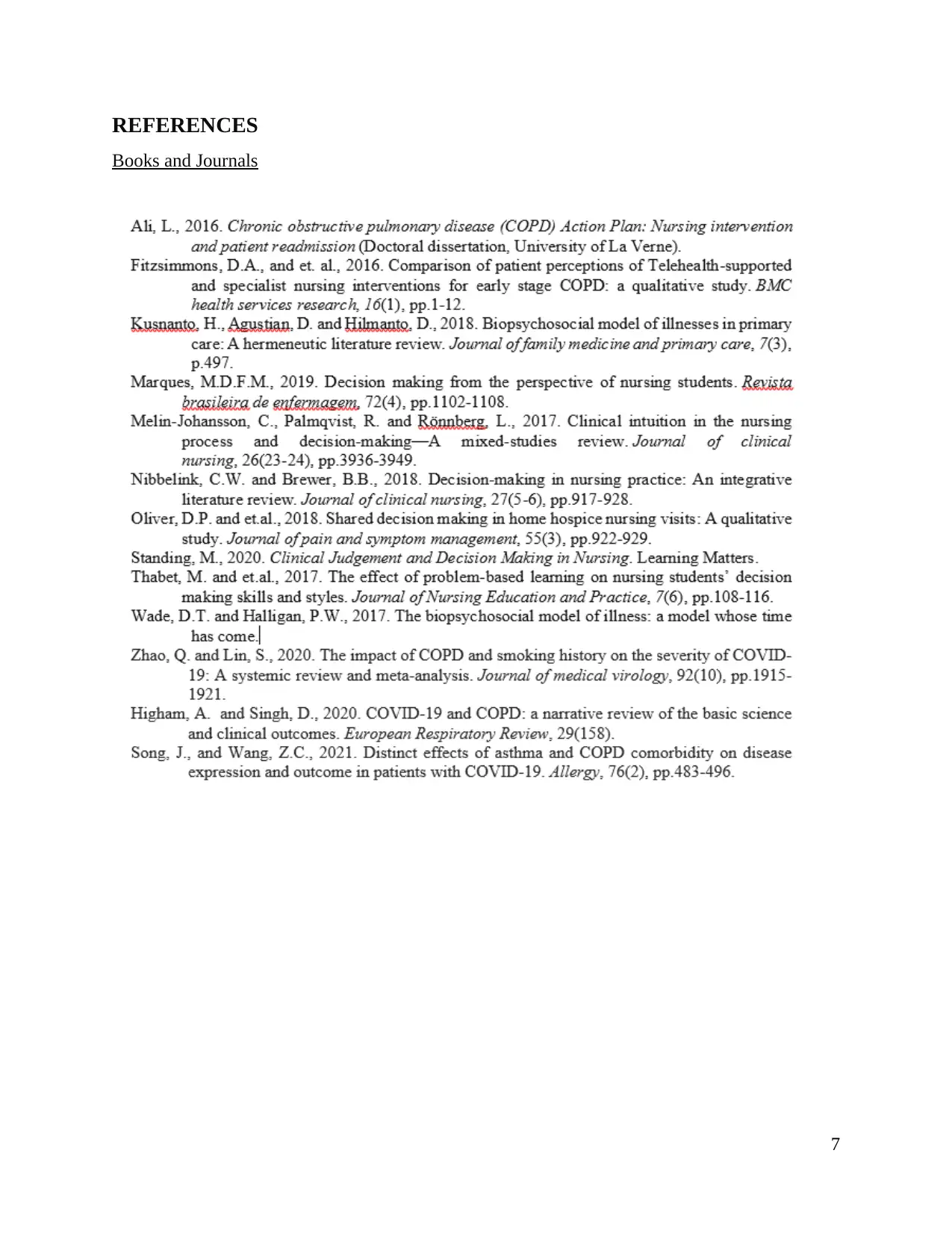
REFERENCES
Books and Journals
7
Books and Journals
7
⊘ This is a preview!⊘
Do you want full access?
Subscribe today to unlock all pages.

Trusted by 1+ million students worldwide
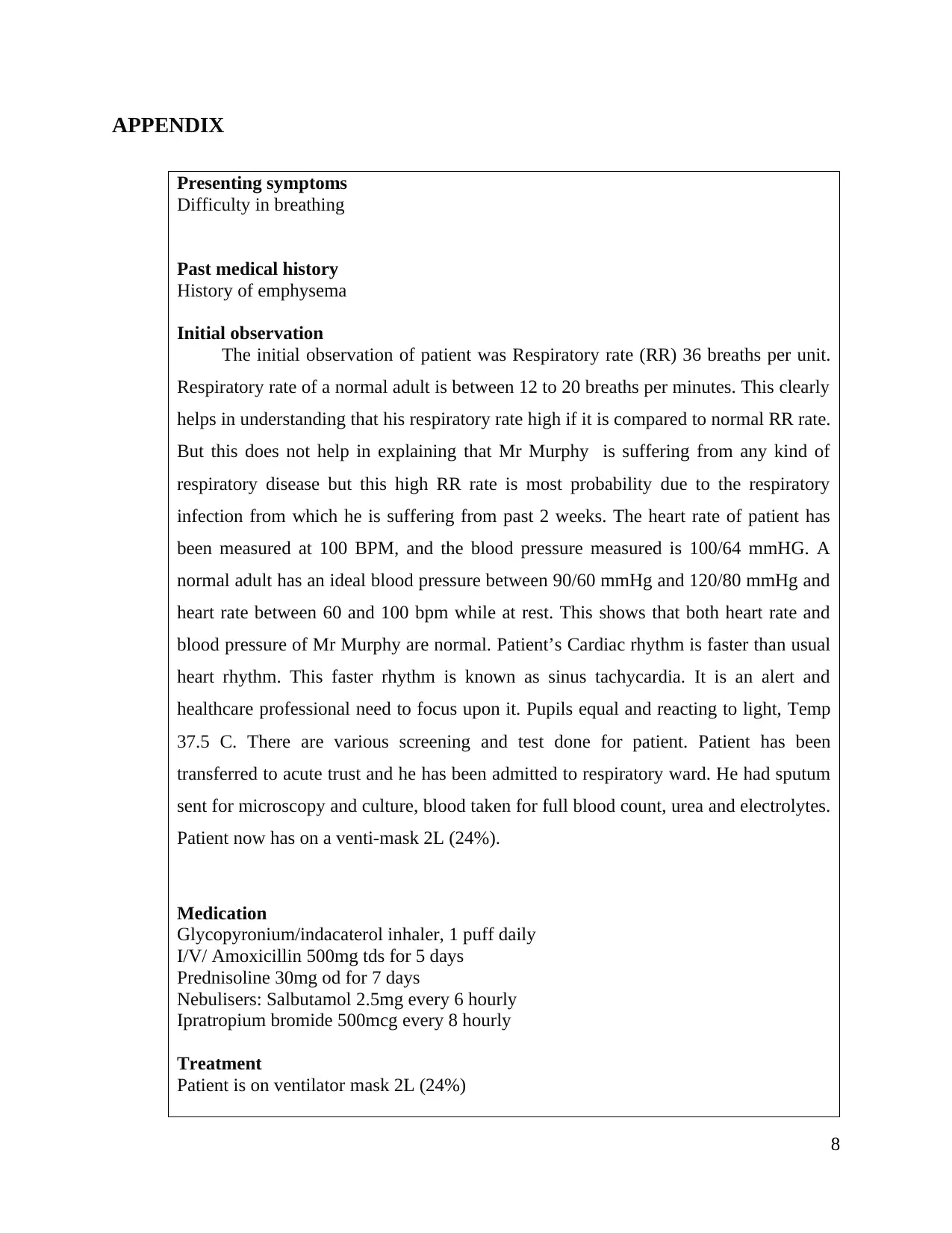
APPENDIX
Presenting symptoms
Difficulty in breathing
Past medical history
History of emphysema
Initial observation
The initial observation of patient was Respiratory rate (RR) 36 breaths per unit.
Respiratory rate of a normal adult is between 12 to 20 breaths per minutes. This clearly
helps in understanding that his respiratory rate high if it is compared to normal RR rate.
But this does not help in explaining that Mr Murphy is suffering from any kind of
respiratory disease but this high RR rate is most probability due to the respiratory
infection from which he is suffering from past 2 weeks. The heart rate of patient has
been measured at 100 BPM, and the blood pressure measured is 100/64 mmHG. A
normal adult has an ideal blood pressure between 90/60 mmHg and 120/80 mmHg and
heart rate between 60 and 100 bpm while at rest. This shows that both heart rate and
blood pressure of Mr Murphy are normal. Patient’s Cardiac rhythm is faster than usual
heart rhythm. This faster rhythm is known as sinus tachycardia. It is an alert and
healthcare professional need to focus upon it. Pupils equal and reacting to light, Temp
37.5 C. There are various screening and test done for patient. Patient has been
transferred to acute trust and he has been admitted to respiratory ward. He had sputum
sent for microscopy and culture, blood taken for full blood count, urea and electrolytes.
Patient now has on a venti-mask 2L (24%).
Medication
Glycopyronium/indacaterol inhaler, 1 puff daily
I/V/ Amoxicillin 500mg tds for 5 days
Prednisoline 30mg od for 7 days
Nebulisers: Salbutamol 2.5mg every 6 hourly
Ipratropium bromide 500mcg every 8 hourly
Treatment
Patient is on ventilator mask 2L (24%)
8
Presenting symptoms
Difficulty in breathing
Past medical history
History of emphysema
Initial observation
The initial observation of patient was Respiratory rate (RR) 36 breaths per unit.
Respiratory rate of a normal adult is between 12 to 20 breaths per minutes. This clearly
helps in understanding that his respiratory rate high if it is compared to normal RR rate.
But this does not help in explaining that Mr Murphy is suffering from any kind of
respiratory disease but this high RR rate is most probability due to the respiratory
infection from which he is suffering from past 2 weeks. The heart rate of patient has
been measured at 100 BPM, and the blood pressure measured is 100/64 mmHG. A
normal adult has an ideal blood pressure between 90/60 mmHg and 120/80 mmHg and
heart rate between 60 and 100 bpm while at rest. This shows that both heart rate and
blood pressure of Mr Murphy are normal. Patient’s Cardiac rhythm is faster than usual
heart rhythm. This faster rhythm is known as sinus tachycardia. It is an alert and
healthcare professional need to focus upon it. Pupils equal and reacting to light, Temp
37.5 C. There are various screening and test done for patient. Patient has been
transferred to acute trust and he has been admitted to respiratory ward. He had sputum
sent for microscopy and culture, blood taken for full blood count, urea and electrolytes.
Patient now has on a venti-mask 2L (24%).
Medication
Glycopyronium/indacaterol inhaler, 1 puff daily
I/V/ Amoxicillin 500mg tds for 5 days
Prednisoline 30mg od for 7 days
Nebulisers: Salbutamol 2.5mg every 6 hourly
Ipratropium bromide 500mcg every 8 hourly
Treatment
Patient is on ventilator mask 2L (24%)
8
Paraphrase This Document
Need a fresh take? Get an instant paraphrase of this document with our AI Paraphraser
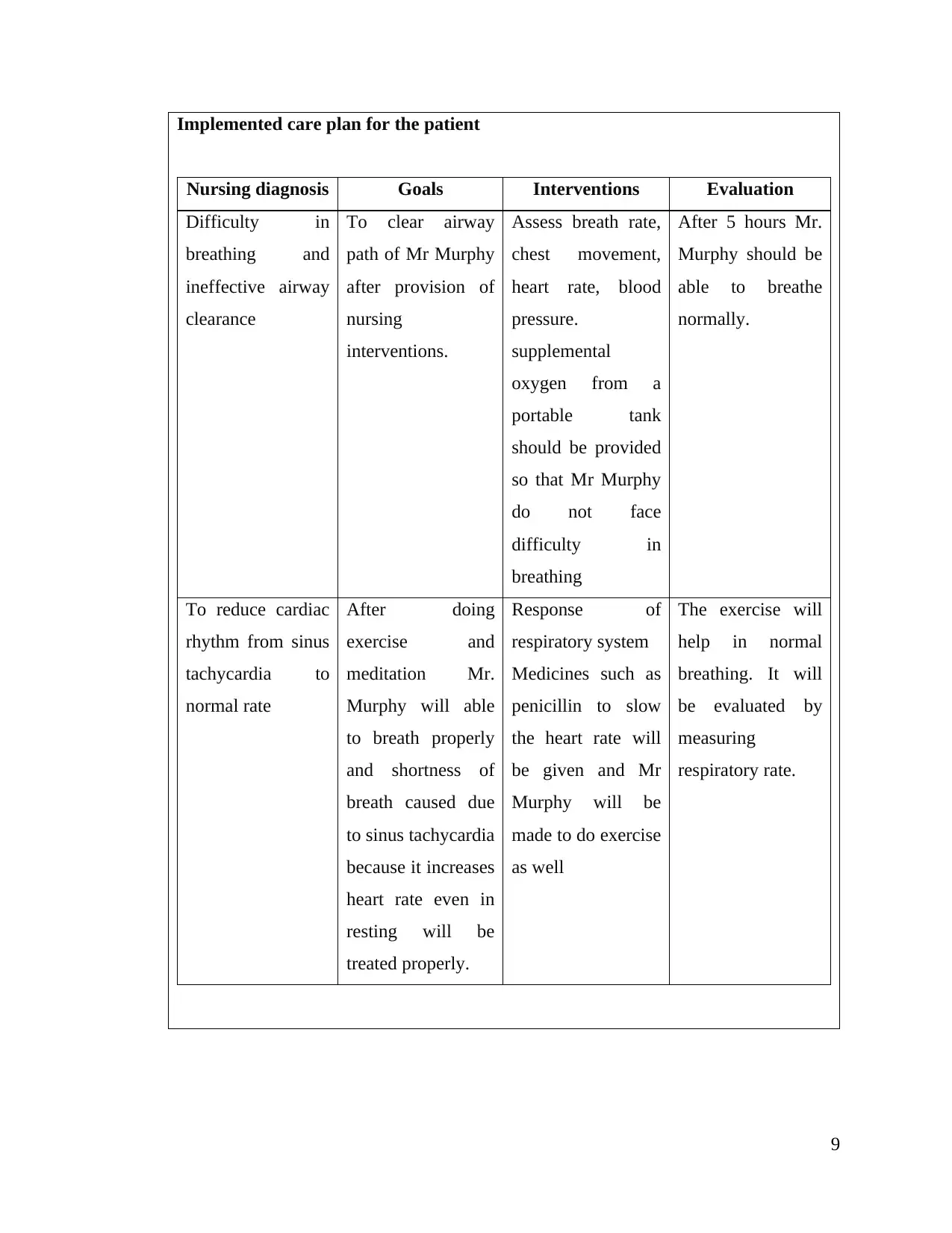
Implemented care plan for the patient
Nursing diagnosis Goals Interventions Evaluation
Difficulty in
breathing and
ineffective airway
clearance
To clear airway
path of Mr Murphy
after provision of
nursing
interventions.
Assess breath rate,
chest movement,
heart rate, blood
pressure.
supplemental
oxygen from a
portable tank
should be provided
so that Mr Murphy
do not face
difficulty in
breathing
After 5 hours Mr.
Murphy should be
able to breathe
normally.
To reduce cardiac
rhythm from sinus
tachycardia to
normal rate
After doing
exercise and
meditation Mr.
Murphy will able
to breath properly
and shortness of
breath caused due
to sinus tachycardia
because it increases
heart rate even in
resting will be
treated properly.
Response of
respiratory system
Medicines such as
penicillin to slow
the heart rate will
be given and Mr
Murphy will be
made to do exercise
as well
The exercise will
help in normal
breathing. It will
be evaluated by
measuring
respiratory rate.
9
Nursing diagnosis Goals Interventions Evaluation
Difficulty in
breathing and
ineffective airway
clearance
To clear airway
path of Mr Murphy
after provision of
nursing
interventions.
Assess breath rate,
chest movement,
heart rate, blood
pressure.
supplemental
oxygen from a
portable tank
should be provided
so that Mr Murphy
do not face
difficulty in
breathing
After 5 hours Mr.
Murphy should be
able to breathe
normally.
To reduce cardiac
rhythm from sinus
tachycardia to
normal rate
After doing
exercise and
meditation Mr.
Murphy will able
to breath properly
and shortness of
breath caused due
to sinus tachycardia
because it increases
heart rate even in
resting will be
treated properly.
Response of
respiratory system
Medicines such as
penicillin to slow
the heart rate will
be given and Mr
Murphy will be
made to do exercise
as well
The exercise will
help in normal
breathing. It will
be evaluated by
measuring
respiratory rate.
9
1 out of 11
Related Documents
Your All-in-One AI-Powered Toolkit for Academic Success.
+13062052269
info@desklib.com
Available 24*7 on WhatsApp / Email
![[object Object]](/_next/static/media/star-bottom.7253800d.svg)
Unlock your academic potential
Copyright © 2020–2025 A2Z Services. All Rights Reserved. Developed and managed by ZUCOL.





